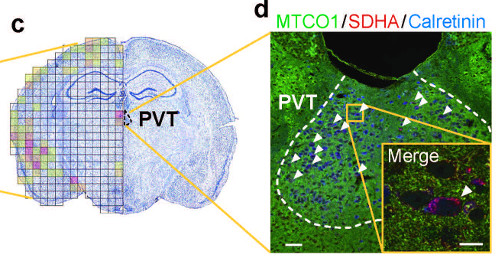Oct. 20, 2015 Press Release Biology Medicine / Disease
First mouse model of spontaneous depression-like episodes
Scientists from the RIKEN Brain Science Institute have shown that a mouse strain with a mutation that leads to dysfunction of mitochondria—the “powerhouses” that provide energy to cells—spontaneously undergo periodic episodes of depression-like behavior that resemble those in human. Through this research, published in Molecular Psychiatry, the scientists uncovered a link between depression and the paraventricular thalamus, a region of the brain not previously tied to depression.
According to Tadafumi Kato, who led the team, "Our work was motivated by the lack of animal models that accurately reproduce depressive episodes. It had been noted previously that mitochondrial diseases were linked to depression, and moreover, that patients with depressive symptoms harbored problems with mitochondrial DNA. We decided to investigate where this was happening, and started experiments with a mouse strain with a mutation in Polg1, which is involved in the replication of mitochondrial DNA."
Examining the behavior of these mutant mice, the researchers discovered that, in a way similar to human patients with mitochondrial diseases, the mice underwent spontaneous episodes where they would express signs and symptoms described in the DSM-5 criteria of major depressive episode in humans.
"What we were surprised to find," says Takaoki Kasahara, one of the first authors of the study, “was that many of the female mutant mice showed symptoms similar to human depression patients. During the episodes, which began without reason and recurrently, the mice would run on their running wheels less extensively, showing they had a lack of pleasure-seeking behavior, a core feature of depression.” The episodes tended to take place approximately every six months, beginning at the age of 30 weeks, and lasted for two or three weeks. When the mice were given an SSRI—a common type of antidepressant drug—the episodes were mitigated, while lithium withdrawal induced episodes. The mice also had higher levels of corticosterone—an equivalent of cortisol in humans, which is often elevated in depressive patients.
During the episodes, the mice showed signs such as weight gain, slow running speed, and increased fatigue, all of which are used to diagnose depression in humans. The researchers then investigated which part of the brain was being affected by the mitochondrial abnormalities. They found that there was a particularly high ratio of deleted mitochondrial DNAs in the paraventricular thalamus, a part of the brain that has not been previously linked to depression. When they examined brain slices from two deceased patients who had suffered from a mitochondrial disease coupled with mood symptoms, they found similar abnormalities in the paraventricular thalamus. To test the association, they blocked the transmission of signals from the paraventricular thalamus to other parts of the brain in mice, and found that they exhibited similar episodes.
“We are excited about this finding,” says Kato, “because this could lead to new therapies for depression, which takes a major health toll on society. Furthermore, this may represent a new mechanism for the onset of depressive episodes. It is also important because if we can show that depression can be caused by mitochondrial abnormalities in an area of the brain, it would allow us to reclassify it as a brain disease with a structural cause rather than a psychiatric illness.”
Reference
- Takaoki Kasahara*, Atsushi Takata*, Tomoaki Kato*, Mie Kubota-Sakashita, Tomoyo Sawada, Akiyoshi Kakita, Hiroaki Mizukami, Daita Kaneda, Keiya Ozawa, Tadafumi Kato (*co-first authors), "Depression-like Episodes in Mice Harboring mtDNA Deletions in Paraventricular Thalamus", Molecular Psychiatry, doi:10.1038/MP.2015.156
Contact
Laboratory Head
Tadafumi Kato
Laboratory for Molecular Dynamics of Mental Disorders
RIKEN Brain Science Institute
Jens Wilkinson
RIKEN Global Relations and Research Coordination Office
Tel: +81-(0)48-462-1225 / Fax: +81-(0)48-463-3687
Email: pr@riken.jp

The recording of the wheel-running activity of female Polg1 mutant mice revealed recurrent spontaneous lethargic episodes similar to clinical depression as defined by DSM-5 criteria.

A comprehensive screen of mutant brain identified marked accumulation of mtDNA deletions in the paraventricular thalamic nucleus (PVT).
